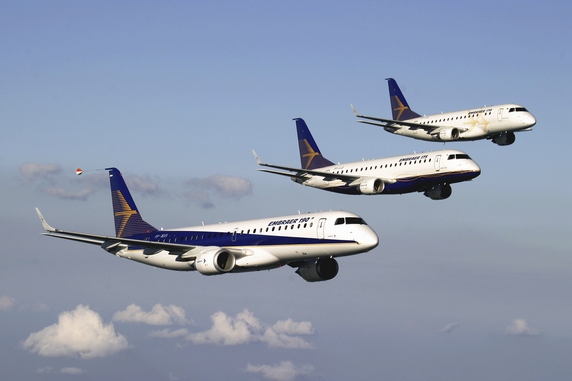Leeham News and Analysis
There's more to real news than a news release.
Exclusive: Embraer turns attention to cargo market, reports Airfinance Journal
By Olivier Bonnassies
Dec. 1, 2020, (c) Airfinance Journal: Embraer is studying the cargo market with a view to launching a freighter conversion programme, sources tell Airfinance Journal.
The Brazilian manufacturer aims to develop a secondary market for converted models in parallel to E2 jet sales and is set to make a decision on a potential Embraer E-Jet freighter conversion in December.

Embraer is weighing P2F conversions for the E195 and E190 E1 jets. The E175 doesn’t have room for a cargo door forward of the engines. Embraer photo.
Embraer was unavailable for comment.
The larger E195 model was involved in Azul Linhas Aereas cargo transportation flights earlier this summer after Brazil’s civil aviation authority granted an exemption for the carriage of additional freight on Embraer passenger aircraft.
“The E190 conversion project is independent from Azul cargo flights,” says one source with knowledge of the manufacturer’s plans. “The idea behind the conversion programme is to get a long-term OEM solution for those fleets,” the source adds.
The Embraer E-Jet freighter conversion will focus on the E190 and E195 models as they fill a gap between the Boeing 737-300 and ATR72 models.
The E190 model is the second-most successful aircraft in Embraer’s product line after the E175. As of 30 September, Embraer had delivered 565 E190s and had a backlog of three units.
Embraer is not studying potential conversion for the smaller members of its fleet because they would lack clearance between the main deck cargo door and the engine, Airfinance Journal understands.
Potential feedstock of E170/175 aircraft is another consideration, although the Brazilian manufacturer continues to sell the E175 model and had a backlog of 153 aircraft and 261 options at the end of the third quarter.
Embraer’s 3Q2020: Embraer announces net loss of $148m
By Bjorn Fehrm
November 10, 2020, ©. Leeham News: Embraer presented its 3Q2020 results today. The revenue was down 35% compared to 3Q2019 at $759m ($1,176m 3Q2019) at deliveries of seven E-Jets (17 3Q2019).
Net loss was -$148m (-$48m 3Q2019), which does not include special charges. Liquidity remains adequate at $2.2bn after issuing new credit facilities during the quarter.
HOTR: With MAX nearing recertification, Boeing has bigger problem
By the Leeham News team
Oct. 27, 2020, © Leeham News: Boeing’s 737 MAX may be nearing recertification and airlines worry about passenger acceptance.
 But Boeing’s larger MAX problem is its general product line-up.
But Boeing’s larger MAX problem is its general product line-up.
LNA pointed out the poor sales of the 7 MAX in the past. We’ve also compared the lagging sales of the 9 MAX and 10 MAX compared with the A321neo.
As a result of the MAX grounding and now COVID-19’s disastrous financial impact on airlines around the world, more than 1,000 orders have been canceled or reclassified as iffy under the ASC 606 accounting rule.
Airbus doesn’t publicly reclassify the European equivalent of ASC 606. But LNA in July estimated how many A320s would be similarly classified. At that time, about 425 appeared to be similarly subject to ASC 606 if this accounting rule was applied to Airbus.
Pontifications: Boeing’s latest forecast raises more doubt than hope
Oct. 12, 2020, © Leeham News: Every year, like clockwork, when Boeing publishes its 20-year Current Market Outlook, there is always another upward revision in forecast demand for new aircraft.
So, when the Chicago-based OEM admits that demand has taken a long-term hit, you know the situation must be dire.
Last week, Boeing belatedly published its annual CMO forecast for global commercial jet production and services. The forecast was quite a comedown as it marked a 2% fall from Boeing’s previous expectations for aircraft demand, with a whopping 10% drop for widebodies and freighters.
Airbus has withheld its 2020 Global Market Forecast while it continues to assess the impact of COVID-19. Read more
A lost decade for aircraft manufacturers, suppliers
Subscription Required
Now open to all Readers
Introduction
By Judson Rollins, Bjorn Fehrm & Scott Hamilton
Sept. 21, 2020, © Leeham News: Commercial aviation is facing a lost decade due to COVID.
Yes, most forecasts target 2024-2025 as returning to 2019 passenger traffic and aircraft production levels.
However, LNA in July published its own analysis indicating full recovery may not occur until 2028. Breathless headlines notwithstanding, it will take years for vaccines to be widely available and considered safe by enough of the world’s population. Growing concern about vaccine production and distribution capacity through 2024 underscores this view. Even Southwest Airlines CEO Gary Kelly said earlier this month that business travel might not fully return for a decade.
Indeed, the 2020s may well be a lost decade for aircraft manufacturers and their supply chains.
 Summary
Summary
- Debt-laden airlines will have little money to order new airplanes
- Interest in re-engined 787, A350 likely nil this decade
- Airbus, Boeing, Embraer have little interest in launching new programs
- Engine makers too financially stretched to develop new designs
- Engineering talent, knowledge will be decimated by inevitable job reductions
- OEMs must “play the long game” at a short-term cost to safeguard their futures
Boeing’s Renton plant may close from 2033: Analysis
Subscription Required
Now open to all Readers.
Introduction
Aug. 10, 2020, © Leeham News: With Boeing likely to consolidate 787 production in Charleston (SC), reflecting a rate of 6/mo, the future of assembly in Puget Sound rears its head again.
LNA outlined Aug. 3 why Everett is the ideal location to assemble the Next Boeing Airplane (NBA).
Boeing’s product line also requires a new airplane in the 100-150 seat sector. Airbus’ A220-100/300 and, nominally, the A320neo (but not the A319neo) fill this sector. (The A320neo was originally designed as a 150-seat airplane. It now is commonly configured in the 150-180 seat size.)
Airbus has a design for an A220-500, which could replace the A320.
Boeing needs an efficient competitor to the current A220 plus a replacement for the 737-7 and, eventually, the -8.
And it probably won’t be assembled at the Boeing 737 plant in Renton.
Summary
- Boeing-Embraer JV was to focus on 100-150 seat airplane.
- Canceled deal could be revived.
- Or Boeing could choose a new partner.
- Moonshot would be two roughly concurrent new airplane programs.
Embraer’s 2Q2020: Revenues more than halved, causing increasing losses
By Bjorn Fehrm
August 5, 2020, ©. Leeham News: Embraer presented its 2Q2020 results today. The revenue virtually halved for 1H2020 to $1.17bn (2.2bn 1H2019) and shrank 61% for the second quarter to $537m ($1,379m 2Q2019), after delivering only four E-Jets during the quarter (26).
Total losses were -$342m ($27m), whereof -$202 was non-operational charges. The COVID crisis hits commercial aircraft deliveries, but Embraer had no cancellation of E-Jet orders in the quarter.
The Executive jet segment is holding up comparatively well, as is Defense and Security.







